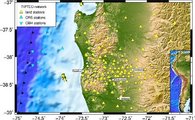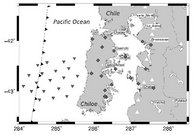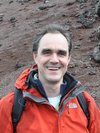The largest earthquakes are being generated at convergent plate boundaries, where oceanic plates subduct beneath other tectonic plates. Understanding the factors leading to these earthquakes in the coupling zone of convergent margins and their interrelation with surface deformation are the main aims of the international and interdisciplinary research initiative TIPTEQ (From The Incoming Plate To megaThrust EarthQuake Processes). The investigation site is located at the continental margin of South Central Chile, where the largest ever instrumentally recorded earthquake (Mw=9.5) occurred on May 22, 1960. High resolution images of the seismogenic zone and the forearc structure will form the base for identifying the processes involved.
Between Nov. 2004 and Oct. 2006 we deployed 2 temporary, amphibious seismic arrays in South-Central Chile. The northern network between 37° and 39°S was formed by up to 120 digitally recording land stations and 10 Ocean Bottom Seismometers/Hydrophones (OBS/OBH) (Fig. 1). The southern network located between 41.5° and 43.5°S at and around Chiloe Island was formed by 20 land stations and 20 OBS/OBH stations (Fig. 2). We observed > 600 local events and many teleseismic earthquakes. Archiving and preprocessing of the data as well as event detection, (1-D) earthquake location and catalog preparation are almost settled. Currently we are working on the 3-D velocity models (tomography), receiver functions, teleseismic tomography, moment tensor inversion, and the geological interpretation (among others).
Within the TIPTEQ seismology group at the University Potsdam and the University of Liverpool we contribute to two subprojects of the TIPTEQ project, "Imaging of properties of the plates interface" ("Abbildung der Eigenschaften der Plattengrenzfläche") and "Lateral variation of the oceanic plate and the marine forearc" ("Laterale Variation der ozeanischen Platte und des marinen Forearcs").
Time Frame
- November 2004 – October 2005
Principal Investigators
- Prof. Andreas Rietbrock (University of Liverpool, leader)
- Dr. Christian Haberland (Uni Potsdamn now GFZ Potsdam)
- Dietrich Lange (Uni Potsdam/Uni Hamburg)
- Prof. Frank Scherbaum (Uni Potsdam)
- Prof. Torsten Dahm (Uni Hamburg, now GFZ Potsdam)
Cooperations
- Prof. Klaus Bataille (Universidad de Concepcion, Chile)
Methods & Equipment
- Temporary Seismic networks
Publications/Results
- Haberland, C.; Rietbrock, A.; Lange, D.; Bataille, K.; Dahm, T. (2009): Structure of the seismogenic zone of the southcentral Chilean margin revealed by local earthquake traveltime tomography. Journal of Geophysical Research, 114, B01317.
- Lange, D.; Cembrano, J.; Rietbrock, A.; Haberland, C.; Dahm, T.; Bataille, K. (2008): First seismic record for intra-arc strike-slip tectonics along the Liquiñe-Ofqui fault zone at the obliquely convergent plate margin of the southern Andes. Tectonophysics, 455, 1-4, 14-24.
- Lange, D.; Rietbrock, A.; Haberland, C.; Bataille, K.; Dahm, T.; Tilmann, F.; Flüh, E. R. (2007): Seismicity and geometry of the south Chilean subduction zone (41.5°S-43.5°S): Implications for controlling parameters. Geophysical Research Letters, 34, L06311.
- Haberland, C.; Rietbrock, A.; Lange, D.; Bataille, K.; Hofmann, S. (2006): Interaction between forearc and oceanic plate at the south-central Chilean margin as seen in local seismic data. Geophysical Research Letters, 33, L23302.
- Rietbrock, A.; Haberland, C.; Bataille, K.; Dahm, T.; Oncken, O. (2005): Studying the Seismogenic Coupling Zone with a Passive Seismic Array. Eos, Transactions, American Geophysical Union, 86, 32, 293, 297.




